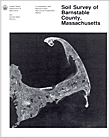The following is a map unit description from the "Soil Survey of Barnstable County, Massachusetts (Fletcher, 1993)"

BmA-Berryland mucky loamy coarse sand, 0 to 2 percent slopes. This very deep, nearly level, very poorly drained soil is in depressions, at the base of swales, and in low areas adjacent to ponds and streams. It formed on outwash plains and in areas of glacial lake deposits. It makes up approximately 0.6 percent (1 662 acres) of the survey area. It is mapped throughout the county. Areas are irregular in shape and range from 5 to 50 acres in size.
Typically, the surface layer is partly organic and partly mineral material. The organic part is about 4 inches of loose, undecomposed sphagnum moss, pine needles, leaves, and twigs and of 2 inches of well decomposed organic material. The mineral part is about 4 inches of very dark gray, very friable loamy coarse sand and 6 inches of gray, loose coarse sand. This part of the surface layer may be gleyed, mottled, or both. The subsoil is dark reddish brown gravelly loamy coarse sand that is firm in the upper 5 inches and friable in the lower 1 1 inches. The substratum to a depth of 65 inches or more is dark reddish brown, loose gravelly coarse sand.
Included with this soil in mapping are small areas of Freetown, Maybid, Pipestone, Swansea, and Walpole soils and areas where the subsoil does not have a firm layer. Also included are areas where the soil shows no evidence of profile development and does not have a mucky surface layer. Included soils make up about 30 percent of this unit.
Permeability is moderately rapid in the subsoil and substratum of the Berryland soil. Available water capacity is low. The seasonal high water table is at or near the surface in fall, winter, and spring. The soil is ponded in some areas.
Most areas are used as woodland. Some areas support shrubby vegetation.
Because of the seasonal high water table, this soil is unsuited to cultivated crops, hay, and pasture. Draining the soil is difficult because suitable outlets are not readily available.
This soil is poorly suited to woodland because of the wetness and a high seedling mortality rate. Optimum tree growth is unlikely, and many seedlings do not survive. Because of low soil strength, the use of equipment should be limited to periods when the soil is dry or frozen. Onsite investigation may identify areas where trees can be planted if special management is applied. The most common trees are red maple, pitch pine, and tupelo.
The seasonal high water table is a limitation affecting most engineering uses of this soil. Alternative sites should be selected.
This soil is well suited to wetland wildlife habitat. The common native plant communities provide adequate food and cover for wildlife nesting areas.